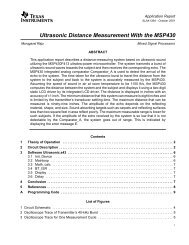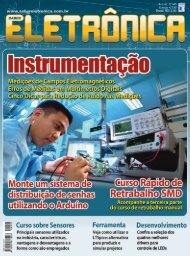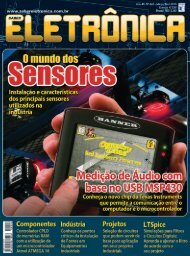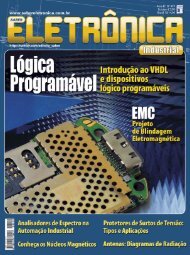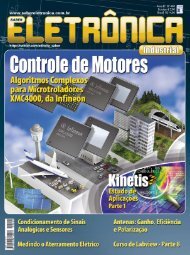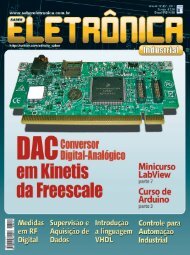DS1620 Digital Thermometer and Thermostat
DS1620 Digital Thermometer and Thermostat
DS1620 Digital Thermometer and Thermostat
You also want an ePaper? Increase the reach of your titles
YUMPU automatically turns print PDFs into web optimized ePapers that Google loves.
www.maxim-ic.com<br />
FEATURES<br />
Requires no external components<br />
Supply voltage range covers from 2.7V to<br />
5.5V<br />
Measures temperatures from -55°C to +125°C<br />
in 0.5°C increments; Fahrenheit equivalent is<br />
-67°F to +257°F in 0.9°F increments<br />
Temperature is read as a 9-bit value<br />
Converts temperature to digital word in 750<br />
ms (max)<br />
<strong>Thermostat</strong>ic settings are user-definable <strong>and</strong><br />
nonvolatile<br />
Data is read from/written via a 3-wire serial<br />
interface (CLK, DQ, RST )<br />
Applications include thermostatic controls,<br />
industrial systems, consumer products,<br />
thermometers, or any thermally sensitive<br />
system<br />
8-pin DIP or SOIC (208-mil) packages<br />
PIN ASSIGNMENT<br />
<strong>DS1620</strong><br />
<strong>Digital</strong> <strong>Thermometer</strong> <strong>and</strong><br />
<strong>Thermostat</strong><br />
PIN DESCRIPTION<br />
DQ - 3-Wire Input/Output<br />
CLK/ CONV - 3-Wire Clock Input <strong>and</strong><br />
St<strong>and</strong>-alone Convert Input<br />
RST - 3-Wire Reset Input<br />
GND - Ground<br />
THIGH - High Temperature Trigger<br />
TLOW - Low Temperature Trigger<br />
TCOM - High/Low Combination Trigger<br />
VDD - Power Supply Voltage (3V - 5V)<br />
DESCRIPTION<br />
The <strong>DS1620</strong> <strong>Digital</strong> <strong>Thermometer</strong> <strong>and</strong> <strong>Thermostat</strong> provides 9–bit temperature readings which indicate<br />
the temperature of the device. With three thermal alarm outputs, the <strong>DS1620</strong> can also act as a thermostat.<br />
THIGH is driven high if the <strong>DS1620</strong>’s temperature is greater than or equal to a user–defined temperature<br />
TH. TLOW is driven high if the <strong>DS1620</strong>’s temperature is less than or equal to a user–defined temperature<br />
TL. TCOM is driven high when the temperature exceeds TH <strong>and</strong> stays high until the temperature falls<br />
below that of TL.<br />
DQ<br />
CLK/CONV<br />
RST<br />
GND<br />
1<br />
2<br />
3<br />
4<br />
1 of 12 053105<br />
8<br />
7<br />
6<br />
5<br />
VDD<br />
THIGH<br />
TLOW<br />
TCOM<br />
<strong>DS1620</strong>S 8-Pin SOIC (208-mil)<br />
DQ<br />
CLK/CONV<br />
RST<br />
GND<br />
1<br />
2<br />
3<br />
4<br />
8<br />
7<br />
6<br />
5<br />
VDD<br />
THIGH<br />
TLOW<br />
TCOM<br />
<strong>DS1620</strong> 8-Pin DIP (300-mil)
<strong>DS1620</strong><br />
User–defined temperature settings are stored in nonvolatile memory, so parts can be programmed prior to<br />
insertion in a system, as well as used in st<strong>and</strong>alone applications without a CPU. Temperature settings <strong>and</strong><br />
temperature readings are all communicated to/from the <strong>DS1620</strong> over a simple 3–wire interface.<br />
ORDERING INFORMATION<br />
PART PACKAGE MARKING DESCRIPTION<br />
<strong>DS1620</strong> <strong>DS1620</strong> 8-Pin DIP (300 mil)<br />
<strong>DS1620</strong>+ <strong>DS1620</strong> (See Note) Lead-Free 8-Pin DIP (300 mil)<br />
<strong>DS1620</strong>S <strong>DS1620</strong> 8-Pin SOIC (208 mil)<br />
<strong>DS1620</strong>S+ <strong>DS1620</strong> (See Note) Lead-Free 8-Pin SOIC (208 mil)<br />
<strong>DS1620</strong>S/T&R <strong>DS1620</strong> 8-Pin SOIC (208 mil), 2000-Piece Tape-<strong>and</strong>-Reel<br />
<strong>DS1620</strong>S+T&R <strong>DS1620</strong> (See Note) Lead-Free 8-Pin SOIC (208 mil), 2000-Piece<br />
Tape-<strong>and</strong>-Reel<br />
Note: A “+” symbol will also be marked on the package near the Pin 1 indicator<br />
DETAILED PIN DESCRIPTION Table 1<br />
PIN SYMBOL DESCRIPTION<br />
1 DQ Data Input/Output pin for 3-wire communication port.<br />
2 CLK/ CONV Clock input pin for 3-wire communication port. When the <strong>DS1620</strong> is used in a<br />
st<strong>and</strong>-alone application with no 3–wire port, this pin can be used as a convert<br />
pin. Temperature conversion will begin on the falling edge of CONV .<br />
3 RST Reset input pin for 3-wire communication port.<br />
4 GND Ground pin.<br />
5 TCOM High/Low Combination Trigger. Goes high when temperature exceeds TH;<br />
will reset to low when temperature falls below TL.<br />
6 TLOW Low Temperature Trigger. Goes high when temperature falls below TL.<br />
7 THIGH High Temperature Trigger. Goes high when temperature exceeds TH.<br />
8 VDD Supply Voltage. 2.7V – 5.5V input power pin.<br />
Table 2. <strong>DS1620</strong> REGISTER SUMMARY<br />
REGISTER NAME<br />
(USER ACCESS)<br />
Temperature<br />
(Read Only)<br />
TH<br />
(Read/Write)<br />
TL<br />
(Read/Write)<br />
SIZE<br />
MEMORY<br />
TYPE<br />
9 Bits SRAM<br />
9 Bits EEPROM<br />
9 Bits EEPROM<br />
OPERATION-MEASURING TEMPERATURE<br />
A block diagram of the <strong>DS1620</strong> is shown in Figure 1.<br />
. .<br />
REGISTER CONTENTS<br />
AND POWER-UP/POR STATE<br />
Measured Temperature (Two’s Complement)<br />
Power-Up/POR State: -60ºC (1 1000 1000)<br />
Upper Alarm Trip Point (Two’s Complement)<br />
Power-Up/POR State: User-Defined.<br />
Initial State from Factory: +15°C (0 0001 1110)<br />
Lower Alarm Trip Point (Two’s Complement)<br />
Power-Up/POR State: User-Defined.<br />
Initial State from Factory: +10°C (0 0001 0100)<br />
2 of 12
<strong>DS1620</strong> FUNCTIONAL BLOCK DIAGRAM Figure 1<br />
3 of 12<br />
<strong>DS1620</strong><br />
The <strong>DS1620</strong> measures temperature using a b<strong>and</strong>gap-based temperature sensor. The temperature reading<br />
is provided in a 9–bit, two’s complement reading by issuing a READ TEMPERATURE comm<strong>and</strong>. The<br />
data is transmitted serially through the 3–wire serial interface, LSB first. The <strong>DS1620</strong> can measure<br />
temperature over the range of -55C to +125C in 0.5C increments. For Fahrenheit usage, a lookup table<br />
or conversion factor must be used.<br />
Since data is transmitted over the 3–wire bus LSB first, temperature data can be written to/read from the<br />
<strong>DS1620</strong> as either a 9–bit word (taking RST low after the 9 th (MSB) bit), or as two transfers of 8–bit<br />
words, with the most significant 7 bits being ignored or set to 0, as illustrated in Table 3. After the MSB,<br />
the <strong>DS1620</strong> will output 0s.<br />
Note that temperature is represented in the <strong>DS1620</strong> in terms of a ½C LSB, yielding the 9–bit format<br />
shown in Figure 2.<br />
TEMPERATURE, TH, <strong>and</strong> TL REGISTER FORMAT Figure 2<br />
MSB<br />
X X X X X X X 1 1 1 0 0 1 1 1 0<br />
T = -25°C<br />
LSB
Table 3 describes the exact relationship of output data to measured temperature.<br />
.<br />
TEMPERATURE/DATA RELATIONSHIPS Table 3<br />
TEMP DIGITAL OUTPUT DIGITAL OUTPUT<br />
(Binary)<br />
(Hex)<br />
+125˚C 0 11111010 00FA<br />
+25˚C 0 00110010 0032h<br />
+½˚C 0 00000001 0001h<br />
+0˚C 0 00000000 0000h<br />
-½˚C 1 11111111 01FFh<br />
-25˚C 1 11001110 01CEh<br />
-55˚C 1 10010010 0192h<br />
4 of 12<br />
<strong>DS1620</strong><br />
Higher resolutions may be obtained by reading the temperature, <strong>and</strong> truncating the 0.5°C bit (the LSB)<br />
from the read value. This value is TEMP_READ. The value left in the counter may then be read by<br />
issuing a READ COUNTER comm<strong>and</strong>. This value is the count remaining (COUNT_REMAIN) after the<br />
gate period has ceased. By loading the value of the slope accumulator into the count register (using the<br />
READ SLOPE comm<strong>and</strong>), this value may then be read, yielding the number of counts per degree C<br />
(COUNT_PER_C) at that temperature. The actual temperature may be then be calculated by the user<br />
using the following:<br />
TEMPERATURE=TEMP_READ-0.25 +<br />
(COUNT_PER_C<br />
- COUNT_REMAIN)<br />
COUNT_PER_C<br />
OPERATION–THERMOSTAT CONTROLS<br />
Three thermally triggered outputs, THIGH, TLOW, <strong>and</strong> TCOM, are provided to allow the <strong>DS1620</strong> to be used<br />
as a thermostat, as shown in Figure 3. When the <strong>DS1620</strong>’s temperature meets or exceeds the value stored<br />
in the high temperature trip register, the output THIGH becomes active (high) <strong>and</strong> remains active until the<br />
<strong>DS1620</strong>’s measured temperature becomes less than the stored value in the high temperature register, TH.<br />
The THIGH output can be used to indicate that a high temperature tolerance boundary has been met or<br />
exceeded, or it can be used as part of a closed loop system to activate a cooling system <strong>and</strong> deactivate it<br />
when the system temperature returns to tolerance.<br />
The TLOW output functions similarly to the THIGH output. When the <strong>DS1620</strong>’s measured temperature<br />
equals or falls below the value stored in the low temperature register, the TLOW output becomes active.<br />
TLOW remains active until the <strong>DS1620</strong>’s temperature becomes greater than the value stored in the low<br />
temperature register, TL. The TLOW output can be used to indicate that a low temperature tolerance<br />
boundary has been met or exceeded, or as part of a closed loop system it can be used to activate a heating<br />
system <strong>and</strong> deactivate it when the system temperature returns to tolerance.<br />
The TCOM output goes high when the measured temperature meets or exceeds TH, <strong>and</strong> will stay high until<br />
the temperature equals or falls below TL. In this way, any amount of hysteresis can be obtained.
THERMOSTAT OUTPUT OPERATION Figure 3<br />
5 of 12<br />
<strong>DS1620</strong><br />
OPERATION AND CONTROL<br />
The <strong>DS1620</strong> must have temperature settings resident in the TH <strong>and</strong> TL registers for thermostatic<br />
operation. A configuration/status register also determines the method of operation that the <strong>DS1620</strong> will<br />
use in a particular application <strong>and</strong> indicates the status of the temperature conversion operation. The<br />
configuration register is defined as follows:<br />
CONFIGURATION/STATUS REGISTER<br />
where<br />
THIGH<br />
TLOW<br />
TCOM<br />
TL TH T(°C)<br />
DONE THF TLF NVB 1 0 CPU 1SHOT<br />
DONE = Conversion Done Bit. 1=conversion complete, 0=conversion in progress. The power-up/POR<br />
state is a 1.<br />
THF = Temperature High Flag. This bit will be set to 1 when the temperature is greater than or equal<br />
to the value of TH. It will remain 1 until reset by writing 0 into this location or by removing power from<br />
the device. This feature provides a method of determining if the <strong>DS1620</strong> has ever been subjected to<br />
temperatures above TH while power has been applied. The power-up/POR state is a 0.<br />
TLF = Temperature Low Flag. This bit will be set to 1 when the temperature is less than or equal to<br />
the value of TL. It will remain 1 until reset by writing 0 into this location or by removing power from the<br />
device. This feature provides a method of determining if the <strong>DS1620</strong> has ever been subjected to<br />
temperatures below TL while power has been applied. The power-up/POR state is a 0.<br />
NVB = Nonvolatile Memory Busy Flag. 1=write to an E 2 memory cell in progress. 0=nonvolatile<br />
memory is not busy. A copy to E 2 may take up to 10 ms. The power-up/POR state is a 0.<br />
CPU = CPU Use Bit. If CPU=0, the CLK/ CONV pin acts as a conversion start control, when RST is<br />
low. If CPU is 1, the <strong>DS1620</strong> will be used with a CPU communicating to it over the 3–wire port, <strong>and</strong> the<br />
operation of the CLK/ CONV pin is as a normal clock in concert with DQ <strong>and</strong> RST . This bit is stored in<br />
nonvolatile E 2 memory, capable of at least 50,000 writes. The <strong>DS1620</strong> is shipped with CPU=0.
<strong>DS1620</strong><br />
1SHOT = One–Shot Mode. If 1SHOT is 1, the <strong>DS1620</strong> will perform one temperature conversion upon<br />
reception of the Start Convert T protocol. If 1SHOT is 0, the <strong>DS1620</strong> will continuously perform<br />
temperature conversion. This bit is stored in nonvolatile E 2 memory, capable of at least 50,000 writes. The<br />
<strong>DS1620</strong> is shipped with 1SHOT=0.<br />
For typical thermostat operation, the <strong>DS1620</strong> will operate in continuous mode. However, for applications<br />
where only one reading is needed at certain times or to conserve power, the one–shot mode may be used.<br />
Note that the thermostat outputs (THIGH, TLOW, TCOM) will remain in the state they were in after the last<br />
valid temperature conversion cycle when operating in one–shot mode.<br />
OPERATION IN STAND–ALONE MODE<br />
In applications where the <strong>DS1620</strong> is used as a simple thermostat, no CPU is required. Since the<br />
temperature limits are nonvolatile, the <strong>DS1620</strong> can be programmed prior to insertion in the system. In<br />
order to facilitate operation without a CPU, the CLK/ CONV pin (pin 2) can be used to initiate<br />
conversions. Note that the CPU bit must be set to 0 in the configuration register to use this mode of<br />
operation. Whether CPU=0 or 1, the 3–wire port is active. Setting CPU=1 disables the st<strong>and</strong>–alone mode.<br />
To use the CLK/ CONV pin to initiate conversions, RST must be low <strong>and</strong> CLK/ CONV must be high. If<br />
CLK/ CONV is driven low <strong>and</strong> then brought high in less than 10 ms, one temperature conversion will be<br />
performed <strong>and</strong> then the <strong>DS1620</strong> will return to an idle state. If CLK/ CONV is driven low <strong>and</strong> remains low,<br />
continuous conversions will take place until CLK/ CONV is brought high again. With the CPU bit set to 0,<br />
the CLK/ CONV will override the 1SHOT bit if it is equal to 1. This means that even if the part is set for<br />
one–shot mode, driving CLK/ CONV low will initiate conversions.<br />
3–WIRE COMMUNICATIONS<br />
The 3–wire bus is comprised of three signals. These are the RST (reset) signal, the CLK (clock) signal,<br />
<strong>and</strong> the DQ (data) signal. All data transfers are initiated by driving the RST input high. Driving the RST<br />
input low terminates communication. (See Figures 4 <strong>and</strong> 5.) A clock cycle is a sequence of a falling edge<br />
followed by a rising edge. For data inputs, the data must be valid during the rising edge of a clock cycle.<br />
Data bits are output on the falling edge of the clock <strong>and</strong> remain valid through the rising edge.<br />
When reading data from the <strong>DS1620</strong>, the DQ pin goes to a high-impedance state while the clock is high.<br />
Taking RST low will terminate any communication <strong>and</strong> cause the DQ pin to go to a high-impedance<br />
state.<br />
Data over the 3–wire interface is communicated LSB first. The comm<strong>and</strong> set for the 3–wire interface as<br />
shown in Table 4 is as follows.<br />
Read Temperature [AAh]<br />
This comm<strong>and</strong> reads the contents of the register which contains the last temperature conversion result.<br />
The next nine clock cycles will output the contents of this register.<br />
Write TH [01h]<br />
This comm<strong>and</strong> writes to the TH (HIGH TEMPERATURE) register. After issuing this comm<strong>and</strong> the next<br />
nine clock cycles clock in the 9–bit temperature limit which will set the threshold for operation of the<br />
THIGH output.<br />
6 of 12
7 of 12<br />
<strong>DS1620</strong><br />
Write TL [02h]<br />
This comm<strong>and</strong> writes to the TL (LOW TEMPERATURE) register. After issuing this comm<strong>and</strong> the next<br />
nine clock cycles clock in the 9–bit temperature limit which will set the threshold for operation of the<br />
TLOW output.<br />
Read TH [A1h]<br />
This comm<strong>and</strong> reads the value of the TH (HIGH TEMPERATURE) register. After issuing this comm<strong>and</strong><br />
the next nine clock cycles clock out the 9–bit temperature limit which sets the threshold for operation of<br />
the THIGH output.<br />
Read TL [A2h]<br />
This comm<strong>and</strong> reads the value of the TL (LOW TEMPERATURE) register. After issuing this comm<strong>and</strong><br />
the next nine clock cycles clock out the 9–bit temperature limit which sets the threshold for operation of<br />
the TLOW output.<br />
Read Counter [A0h]<br />
This comm<strong>and</strong> reads the value of the counter byte. The next nine clock cycles will output the contents of<br />
this register.<br />
Read Slope [A9h]<br />
This comm<strong>and</strong> reads the value of the slope counter byte from the <strong>DS1620</strong>. The next nine clock cycles<br />
will output the contents of this register.<br />
Start Convert T [EEh]<br />
This comm<strong>and</strong> begins a temperature conversion. No further data is required. In one–shot mode the<br />
temperature conversion will be performed <strong>and</strong> then the <strong>DS1620</strong> will remain idle. In continuous mode this<br />
comm<strong>and</strong> will initiate continuous conversions.<br />
Stop Convert T [22h]<br />
This comm<strong>and</strong> stops temperature conversion. No further data is required. This comm<strong>and</strong> may be used to<br />
halt a <strong>DS1620</strong> in continuous conversion mode. After issuing this comm<strong>and</strong> the current temperature<br />
measurement will be completed <strong>and</strong> then the <strong>DS1620</strong> will remain idle until a Start Convert T is issued to<br />
resume continuous operation.<br />
Write Config [0Ch]<br />
This comm<strong>and</strong> writes to the configuration register. After issuing this comm<strong>and</strong> the next eight clock cycles<br />
clock in the value of the configuration register.<br />
Read Config [ACh]<br />
This comm<strong>and</strong> reads the value in the configuration register. After issuing this comm<strong>and</strong> the next eight<br />
clock cycles output the value of the configuration register.
<strong>DS1620</strong> COMMAND SET Table 4<br />
8 of 12<br />
<strong>DS1620</strong><br />
INSTRUCTION DESCRIPTION<br />
PROTOCOL<br />
3-WIRE BUS<br />
DATA AFTER<br />
ISSUING<br />
PROTOCOL NOTES<br />
TEMPERATURE CONVERSION COMMANDS<br />
Read Temperature Reads last converted temperature<br />
value from temperature register.<br />
AAh <br />
Read Counter Reads value of count remaining<br />
from counter.<br />
A0h <br />
Read Slope Reads value of the slope<br />
accumulator.<br />
A9h <br />
Start Convert T Initiates temperature conversion. EEh Idle 1<br />
Stop Convert T Halts temperature conversion. 22h Idle 1<br />
THERMOSTAT COMMANDS<br />
Write TH Writes high temperature limit value<br />
into TH register.<br />
01h 2<br />
Write TL Writes low temperature limit value<br />
into TL register.<br />
02h 2<br />
Read TH Reads stored value of high<br />
temperature limit from TH register.<br />
A1h 2<br />
Read TL Reads stored value of low<br />
temperature limit from TL register.<br />
A2h 2<br />
Write Config Writes configuration data to<br />
configuration register.<br />
0Ch 2<br />
Read Config Reads configuration data from<br />
configuration register.<br />
ACh 2<br />
NOTES:<br />
1. In continuous conversion mode, a Stop Convert T comm<strong>and</strong> will halt continuous conversion. To<br />
restart, the Start Convert T comm<strong>and</strong> must be issued. In one–shot mode, a Start Convert T comm<strong>and</strong><br />
must be issued for every temperature reading desired.<br />
2. Writing to the E 2 requires up to 10 ms at room temperature. After issuing a write comm<strong>and</strong> no further<br />
writes should be requested for at least 10 ms.
FUNCTION EXAMPLE<br />
Example: CPU sets up <strong>DS1620</strong> for continuous conversion <strong>and</strong> thermostatic function.<br />
<strong>DS1620</strong> MODE<br />
CPU MODE (3-WIRE) DATA (LSB FIRST)<br />
COMMENTS<br />
TX RX 0Ch CPU issues Write Config comm<strong>and</strong><br />
TX RX 00h CPU sets <strong>DS1620</strong> up for continuous<br />
conversion<br />
TX RX Toggle RST CPU issues Reset to <strong>DS1620</strong><br />
TX RX 01h CPU issues Write TH comm<strong>and</strong><br />
TX RX 0050h CPU sends data for TH limit of +40˚C<br />
TX RX Toggle RST CPU issues Reset to <strong>DS1620</strong><br />
TX RX 02h CPU issues Write TL comm<strong>and</strong><br />
TX RX 0014h CPU sends data for TL limit of +10˚C<br />
TX RX Toggle RST CPU issues Reset to <strong>DS1620</strong><br />
TX RX A1h CPU issues Read TH comm<strong>and</strong><br />
RX TX 0050h <strong>DS1620</strong> sends back stored value of TH for<br />
CPU to verify<br />
TX RX Toggle RST CPU issues Reset to <strong>DS1620</strong><br />
TX RX A2h CPU issues Read TL comm<strong>and</strong><br />
RX TX 0014h <strong>DS1620</strong> sends back stored value of TL for<br />
CPU to verify<br />
TX RX Toggle RST CPU issues Reset to <strong>DS1620</strong><br />
TX RX EEh CPU issues Start Convert T comm<strong>and</strong><br />
TX RX Drop RST CPU issues Reset to <strong>DS1620</strong><br />
READ DATA TRANSFER Figure 4<br />
9 of 12<br />
<strong>DS1620</strong>
WRITE DATA TRANSFER Figure 5<br />
NOTE: tCL, tCH, tR, <strong>and</strong> tF apply to both read <strong>and</strong> write data transfer.<br />
ABSOLUTE MAXIMUM RATINGS*<br />
Voltage on Any Pin Relative to Ground –0.5V to +6.0V<br />
Operating Temperature –55C to +125C<br />
Storage Temperature –55C to +125C<br />
Soldering Temperature 260C for 10 seconds<br />
10 of 12<br />
<strong>DS1620</strong><br />
* This is a stress rating only <strong>and</strong> functional operation of the device at these or any other conditions above<br />
those indicated in the operation sections of this specification is not implied. Exposure to absolute<br />
maximum rating conditions for extended periods of time may affect reliability.<br />
RECOMMENDED DC OPERATING CONDITIONS<br />
PARAMETER SYMBOL MIN TYP MAX UNITS NOTES<br />
Supply VDD 2.7 5.5 V 1,2<br />
Logic 1 VIH 0.7 x VDD VCC + 0.3 V 1<br />
Logic 0 VIL -0.3 0.3 x VDD V 1
11 of 12<br />
<strong>DS1620</strong><br />
DC ELECTRICAL CHARACTERISTICS (-55°C to +125°C; VDD=2.7V to 5.5V)<br />
PARAMETER SYMBOL CONDITION MIN MAX UNITS NOTES<br />
<strong>Thermometer</strong> Error TERR 0°C to +70°C<br />
3.0V ≤ VDD ≤ 5.5V<br />
±0.5 C 2<br />
0°C to +70°C<br />
2.7V ≤ VDD < 3.0V<br />
±1.25<br />
-55C to +125C ±2.0<br />
<strong>Thermometer</strong> Resolution 12 Bits<br />
Logic 0 Output VOL 0.4 V 4<br />
Logic 1 Output VOH 2.4 V 5<br />
Input Resistance RI RST to GND<br />
DQ, CLK to VDD<br />
1<br />
1<br />
M<br />
M<br />
Active Supply Current ICC 0°C to +70°C 1 mA 6<br />
St<strong>and</strong>by Supply Current ISTBY 0°C to +70°C 1.5 µA 6<br />
Input Current on Each<br />
Pin<br />
0.4 < VI/O < 0.9 x VDD -10 +10 µA<br />
Thermal Drift ±0.2 °C 7<br />
SINGLE CONVERT TIMING DIAGRAM (STAND-ALONE MODE)<br />
CONV<br />
AC ELECTRICAL CHARACTERISTICS (-55°C to +125°C; VDD=2.7V to 5.5V)<br />
PARAMETERS SYMBOL MIN TYP MAX UNITS NOTES<br />
Temperature Conversion Time TTC 750 ms<br />
Data to CLK Setup tDC 35 ns 8<br />
CLK to Data Hold tCDH 40 ns 8<br />
CLK to Data Delay tCDD 150 ns 8, 9, 10<br />
CLK Low Time tCL 285 ns 8<br />
CLK High Time tCH 285 ns 8<br />
CLK Frequency fCLK DC 1.75 MHz 8<br />
CLK Rise <strong>and</strong> Fall tR, tF 500 ns<br />
RST to CLK Setup tCC 100 ns 8<br />
CLK to RST Hold tCCH 40 ns 8<br />
RST Inactive Time tCWH 125 ns 8, 11<br />
CLK High to I/O High-Z tCDZ 50 ns 8<br />
RST Low to I/O High-Z tRDZ 50 ns 8<br />
Convert Pulse Width tCNV 250 ns 500 ms 12<br />
tCNV
AC ELECTRICAL CHARACTERISTICS<br />
<strong>DS1620</strong><br />
(-55°C to +125°C; VDD=2.7V to 5.5V)<br />
PARAMETER SYMBOL MIN TYP MAX UNITS NOTES<br />
Input Capacitance CI 5 pF<br />
I/O Capacitance CI/O 10 pF<br />
EEPROM AC ELECTRICAL CHARACTERISTICS<br />
(-55°C to +125°C; VDD=2.7V to 5.5V)<br />
PARAMETER CONDITIONS MIN TYP MAX UNITS<br />
EEPROM Write Cycle Time 4 10 Ms<br />
EEPROM Writes -55C to +55C 50k Writes<br />
EEPROM Data Retention -55C to +55C 10 Years<br />
NOTES:<br />
1. All voltages are referenced to ground.<br />
2. Valid for design revisions D1 <strong>and</strong> above. The supply range for Rev. C2 <strong>and</strong> below is 4.5V < 5.5V.<br />
3. <strong>Thermometer</strong> error reflects temperature accuracy as tested during calibration.<br />
4. Logic 0 voltages are specified at a sink current of 4 mA<br />
5. Logic 1 voltages are specified at a source current of 1 mA.<br />
6. ISTBY, ICC specified with DQ, CLK/ CONV = VDD, <strong>and</strong> RST = GND.<br />
7. Drift data is based on a 1000hr stress test at +125°C with VDD = 5.5V<br />
8. Measured at VIH = 0.7 x VDD or VIL = 0.3 x VDD.<br />
9. Measured at VOH = 2.4V or VOL = 0.4V.<br />
10. Load capacitance = 50 pF.<br />
11. tCWH must be 10 ms minimum following any write comm<strong>and</strong> that involves the E 2 memory.<br />
12. 250ns is the guaranteed minimum pulse width for a conversion to start; however, a smaller pulse<br />
width may start a conversion.<br />
12 of 12







